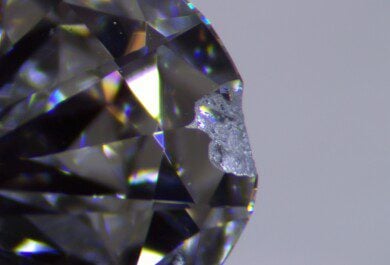In choosing a diamond dealer or jeweler, many people are interested in the possibility of trading in their stone at some time in the future. This is part of the value added sales pitch for a significant percentage of the jewelers and evaluating these programs can be remarkably difficult. I’ll try to narrow it down a bit.
They basically come in 4 varieties. Refund, Buyback, Trade-up and Trade-in. Here’s a rundown of the differences.
Refunds
Most dealers will offer a refund if you’re unhappy with your purchases within a certain amount of time and it is highly recommended that you shop with a store that has a refund policy. This is for purposes of evaluating your purchase to see if it’s right for you and, if not, they’re undo the deal. Think of it as a test drive. This is separate, although related, to a warranty that what they’re selling is free from material defects and that it’s as described. You can use the time to get it appraised, show it to your friends and neighbors, compare it to offers from other jewelers, check it out with your astrologer or whatever is important to you in making sure you get exactly what you want. Normally there will be a fairly short time limit for a refund and this limit will vary wildly from one dealer to the next. Some are as short as zero and some are as long as forever but typical for Internet type vendors is 10-30 days. Neighborhood stores seem to range from zero to 30 days depending on the store. One of the first rules in choosing a jeweler is this:
UNDERSTAND THE RETURN POLICY BEFORE YOU COMMIT TO BUY
Policies also vary quite a bit in terms of their limitations and qualifications. Some will give a refund for any reason whatsoever as long as you return the merchandise in saleable condition and within the proscribed time and some add a litany of rules so complicated that make it’s effectively impossible to comply. Common limitations, beyond the timing, include restrictions on what constitutes an acceptable complaint, limits on who did the appraisal that was the basis of the complaint, removal of tags, resizing (even when done by them) and other things. There are quite a few other choices and the amount of difficulty they add here is a good clue for how much trouble you can expect from a particular jeweler. Here are my recommendations for what to look for in the terms and conditions.
100% refund with no restocking fee if the merchandise is returned in original condition for any reason as long as it’s within the required time. Shipping and handling fees excluded. The refund will be done punctually and in the same form as your original payment.
Buyback
This is an agreement by a selling jeweler that they will buy back the item beyond the refund period. Buyback offers are actually pretty unusual in the jewelry business for a variety of reasons, not the least of which is that they represent a potential for a significant liability for the jeweler. The policy obligates the store forever in a way that’s hard for their accountants to track and holds the potential for serious problems if diamonds take a significant downturn.
There’s an important restriction here. By ‘buy back’, I mean cash. Those who do it usually have limitations based on a percentage of the original purchase price. 75% or so of the selling price seem to be fairly common with the places that do it but again, zero is the most popular offering. It’s a strong vote of confidence by the jeweler in what they’re selling but I wouldn’t hold it against them if they don’t include this in their bundle of benefits.
Buyback programs are a restriction on the jeweler but not the buyer. That’s why they don’t like them. They HAVE to pay whatever is agreed but you are under no obligation to accept. You can sell it privately, you can trade-in at another jeweler and maybe even trade-in there. If diamonds take a price dive there’s serious risk of bankruptcy for the jeweler because they’re going to be loading up their inventory at old (higher) prices and if they go through the roof then no one will bring them back so they don’t get the benefit. At best it’s a wash and at worst it’s a disaster. Often the programs are coming from the manufacturer, not the jeweler themselves so if the store carries a variety of goods you can expect that the buyback policies, when they exist, will only apply to certain items in the store.
The solution for the jewelers is to offer a trade-up program as an alternative.
Trade up
This is a limited form of buy back where you are obligated to spend your money on something else in the same store but usually there’s no time requirement. Unlike buyback offers, they’re common, and there are ALWAYS limitations. The most common limitation is that you must spend double the purchase price on the new item but also it’s common to limit both which items you can trade in and which items you can purchase with the proceeds. As with the above, there are usually fees for restocking, regrading, resetting and other things when you actually do the deal. Almost always it’s necessary to spend 100% of the proceeds on a new diamond. It’s also common for trade up policies only to apply to diamonds over a certain size or price put but to excludes mountings and/or other gemstones. Most programs will only include certain brands so if you’re interested, make sure that what you’re buying is part of it. You can’t just assume that the rules will be the same for every item in the store. Lastly it’s common to tie this in with the warranty and to include limitations like a requirement that the piece be inspected periodically, that you pay for whatever repairs they recommend and that it never be worked on by another jeweler.
Like buybacks, trade up programs are contracts requiring certain things of the jeweler but, unlike the buybacks, they also contain requirements for you. Don’t get too annoyed if they aren’t quite as fabulous as the salespeople make them sound. That’s what salespeople are for. Read the policy rather than just listen to the pitch. They do have their merits, but they’re not a panacea.
These get promoted quite heavily by some fairly popular stores as a reason to buy from them and some customers really do benefit significantly from them. It eliminates the need to get involved in the resale marketplace and it allows you to have a stone ‘on hand’ while you’re saving up enough money to buy what you REALLY want. At the same time, a lot of people end up paying quite a bit extra in order to get a trade up program that they never end up using or that’s so limited as to be useless. The trick, as they say, is in the details. Read the fine print. It’s easy to get into a position where you’re feeling obligated to buy from a particular jeweler in order to maintain the trade up eligibility and you end up overpaying a second time, paying for ‘repairs’ that are unnecessary or expensive, or voiding your own program without knowing it by doing or not doing something.
Trade in
The difference between trade in and trade up or buyback is that the jeweler isn’t REQUIRED to do the deal based on your original purchase contract. It’s going to be about the details of the stone, not your prior purchase. Trading in can involve stones that you didn’t buy from them or that they sold but that aren’t eligible for their trade up program for whatever reason. It’s basically just a second deal where you sell one stone and buy another. They can buy or avoid whatever they want and they can offer to pay whatever they want. You, in turn, can take it or leave it. There’s no obligation on either one of you. This is what causes people confusion. The jeweler is probably not going to give you what you paid and the difference is often quite a bit, especially if they didn’t sell it to you originally. Jewelers are in the business to make money. They, or whoever sold it to you, made money on the first deal and they plan to make money on this second deal when they sell it to someone else. That’s just a fundamental of the business so don’t be offended if they make an offer that strikes you as unreasonable. Just say no, and then shop it around. Maybe someone else will pay more and, if not, you can always come back. Diamonds aren’t perishable and most valid offers will still be on the table in a few days if you want to think about it for awhile.
A lot of jewelers flatly refuse to do trade-in’s precisely because they don’t want to offend people with what might be seen as an unfair offer. They would rather duck a deal that might be a good opportunity for both of you than to take the chance that you’ll walk away mad, thus losing them both a buy and a sale. It’s also common, especially with large chain type stores, to refuse to do them simply because they don’t have the staff with the skills to evaluate a purchase. Buying diamonds from the public is a VERY different skill set from selling things at the mall.
Are they worth it?
For some people, yes they are, especially if you get a good one and you go into it understanding what you’re getting. For most, no they’re not. Only you can say which group you’re in. If you’re going to make a purchase and one of these programs is going to be part of your decision process, remember that these too can be shopped. What type are they? How long do they last? What restrictions, if any, are there to keep it in force, and under what circumstances can you use it?
by Neil Beaty
Professional Appraisals in Denver
http://www.americangemregistry.com/

Click here to discuss on the Forum











